Jiali Cheng
FUTURE: Flexible Unlearning for Tree Ensemble
Aug 28, 2025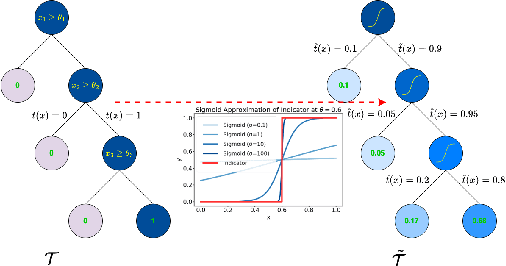
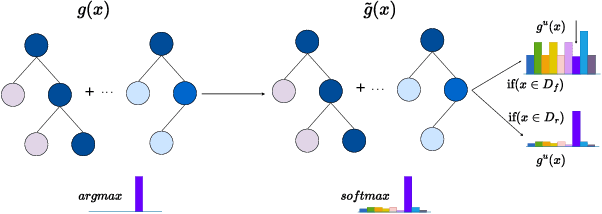
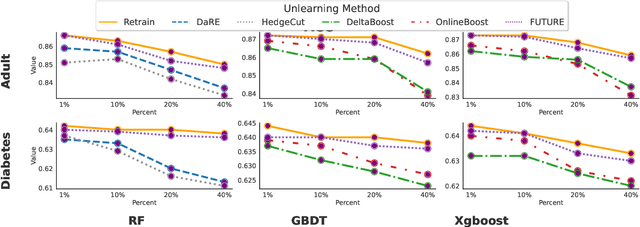

Abstract:Tree ensembles are widely recognized for their effectiveness in classification tasks, achieving state-of-the-art performance across diverse domains, including bioinformatics, finance, and medical diagnosis. With increasing emphasis on data privacy and the \textit{right to be forgotten}, several unlearning algorithms have been proposed to enable tree ensembles to forget sensitive information. However, existing methods are often tailored to a particular model or rely on the discrete tree structure, making them difficult to generalize to complex ensembles and inefficient for large-scale datasets. To address these limitations, we propose FUTURE, a novel unlearning algorithm for tree ensembles. Specifically, we formulate the problem of forgetting samples as a gradient-based optimization task. In order to accommodate non-differentiability of tree ensembles, we adopt the probabilistic model approximations within the optimization framework. This enables end-to-end unlearning in an effective and efficient manner. Extensive experiments on real-world datasets show that FUTURE yields significant and successful unlearning performance.
Understanding Machine Unlearning Through the Lens of Mode Connectivity
Apr 08, 2025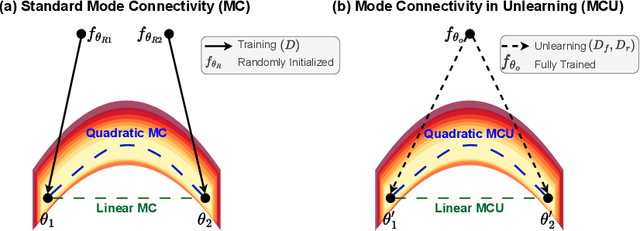


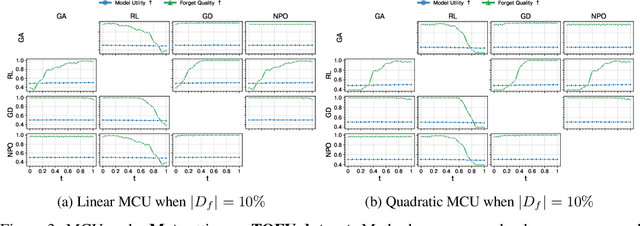
Abstract:Machine Unlearning aims to remove undesired information from trained models without requiring full retraining from scratch. Despite recent advancements, their underlying loss landscapes and optimization dynamics received less attention. In this paper, we investigate and analyze machine unlearning through the lens of mode connectivity - the phenomenon where independently trained models can be connected by smooth low-loss paths in the parameter space. We define and study mode connectivity in unlearning across a range of overlooked conditions, including connections between different unlearning methods, models trained with and without curriculum learning, and models optimized with first-order and secondorder techniques. Our findings show distinct patterns of fluctuation of different evaluation metrics along the curve, as well as the mechanistic (dis)similarity between unlearning methods. To the best of our knowledge, this is the first study on mode connectivity in the context of machine unlearning.
Linguistic Blind Spots of Large Language Models
Mar 25, 2025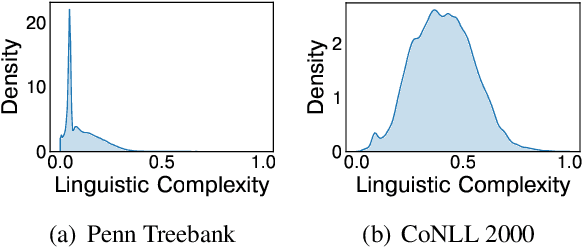
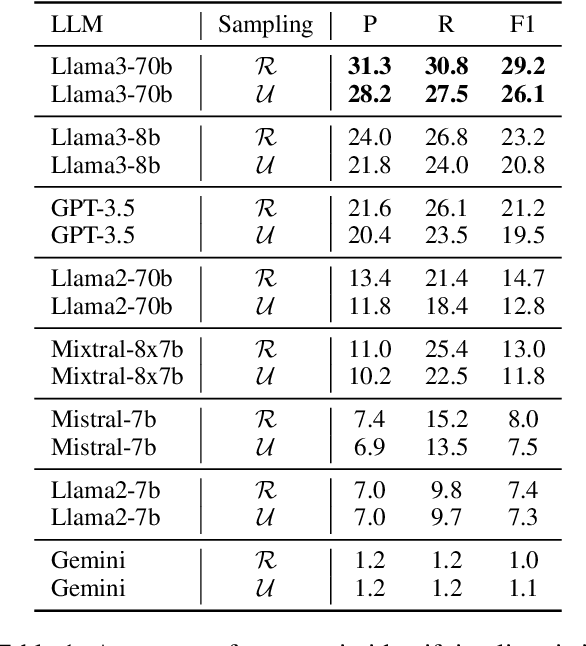
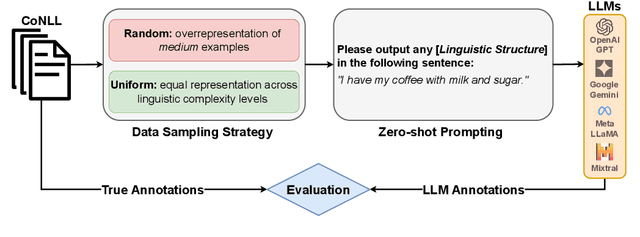

Abstract:Large language models (LLMs) are the foundation of many AI applications today. However, despite their remarkable proficiency in generating coherent text, questions linger regarding their ability to perform fine-grained linguistic annotation tasks, such as detecting nouns or verbs, or identifying more complex syntactic structures like clauses in input texts. These tasks require precise syntactic and semantic understanding of input text, and when LLMs underperform on specific linguistic structures, it raises concerns about their reliability for detailed linguistic analysis and whether their (even correct) outputs truly reflect an understanding of the inputs. In this paper, we empirically study the performance of recent LLMs on fine-grained linguistic annotation tasks. Through a series of experiments, we find that recent LLMs show limited efficacy in addressing linguistic queries and often struggle with linguistically complex inputs. We show that the most capable LLM (Llama3-70b) makes notable errors in detecting linguistic structures, such as misidentifying embedded clauses, failing to recognize verb phrases, and confusing complex nominals with clauses. Our results provide insights to inform future advancements in LLM design and development.
* NAACL 2025 Cognitive Modeling and Computational Linguistics Workshop
Tool Unlearning for Tool-Augmented LLMs
Feb 03, 2025



Abstract:Tool-augmented large language models (LLMs) are often trained on datasets of query-response pairs, which embed the ability to use tools or APIs directly into the parametric knowledge of LLMs. Tool-augmented LLMs need the ability to forget learned tools due to security vulnerabilities, privacy regulations, or tool deprecations. However, ``tool unlearning'' has not been investigated in unlearning literature. We introduce this novel task, which requires addressing distinct challenges compared to traditional unlearning: knowledge removal rather than forgetting individual samples, the high cost of optimizing LLMs, and the need for principled evaluation metrics. To bridge these gaps, we propose ToolDelete, the first approach for unlearning tools from tool-augmented LLMs. It implements three key properties to address the above challenges for effective tool unlearning and introduces a new membership inference attack (MIA) model for effective evaluation. Extensive experiments on multiple tool learning datasets and tool-augmented LLMs show that ToolDelete effectively unlearns randomly selected tools, while preserving the LLM's knowledge on non-deleted tools and maintaining performance on general tasks.
MedDec: A Dataset for Extracting Medical Decisions from Discharge Summaries
Aug 23, 2024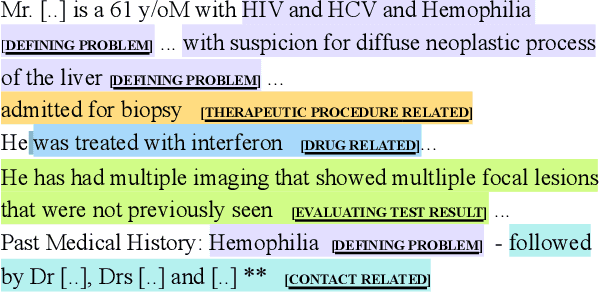
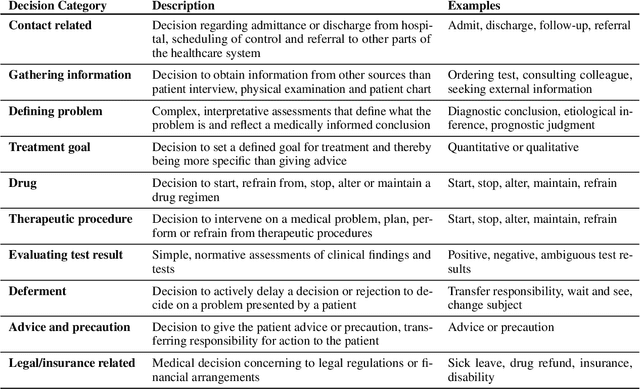
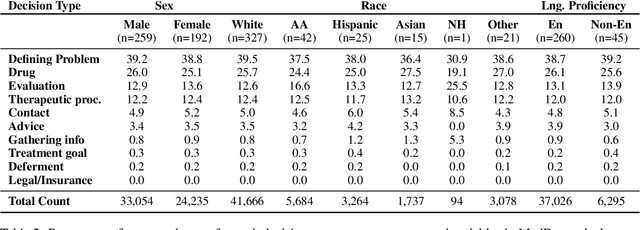
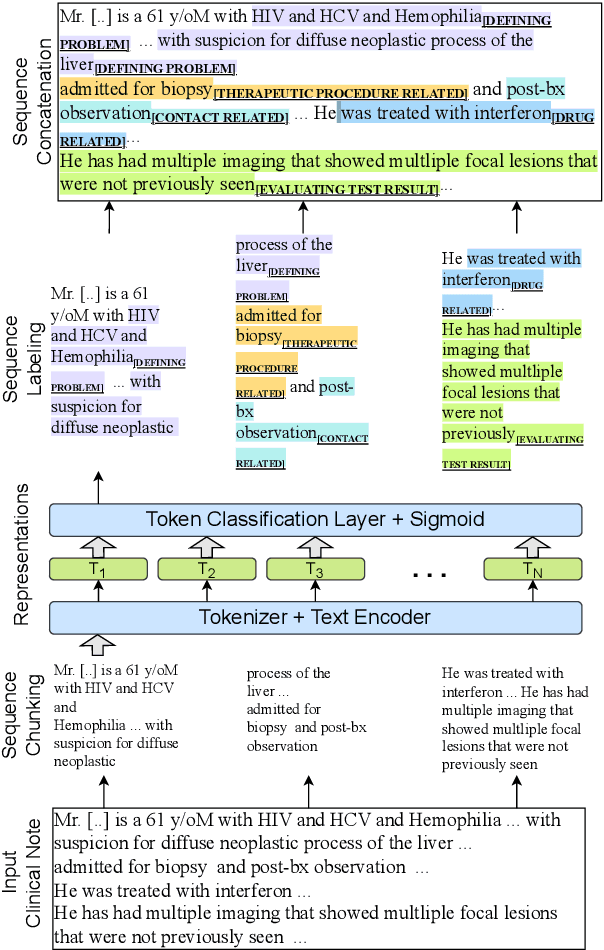
Abstract:Medical decisions directly impact individuals' health and well-being. Extracting decision spans from clinical notes plays a crucial role in understanding medical decision-making processes. In this paper, we develop a new dataset called "MedDec", which contains clinical notes of eleven different phenotypes (diseases) annotated by ten types of medical decisions. We introduce the task of medical decision extraction, aiming to jointly extract and classify different types of medical decisions within clinical notes. We provide a comprehensive analysis of the dataset, develop a span detection model as a baseline for this task, evaluate recent span detection approaches, and employ a few metrics to measure the complexity of data samples. Our findings shed light on the complexities inherent in clinical decision extraction and enable future work in this area of research. The dataset and code are available through https://github.com/CLU-UML/MedDec.
CogniVoice: Multimodal and Multilingual Fusion Networks for Mild Cognitive Impairment Assessment from Spontaneous Speech
Jul 18, 2024Abstract:Mild Cognitive Impairment (MCI) is a medical condition characterized by noticeable declines in memory and cognitive abilities, potentially affecting individual's daily activities. In this paper, we introduce CogniVoice, a novel multilingual and multimodal framework to detect MCI and estimate Mini-Mental State Examination (MMSE) scores by analyzing speech data and its textual transcriptions. The key component of CogniVoice is an ensemble multimodal and multilingual network based on ``Product of Experts'' that mitigates reliance on shortcut solutions. Using a comprehensive dataset containing both English and Chinese languages from TAUKADIAL challenge, CogniVoice outperforms the best performing baseline model on MCI classification and MMSE regression tasks by 2.8 and 4.1 points in F1 and RMSE respectively, and can effectively reduce the performance gap across different language groups by 0.7 points in F1.
MU-Bench: A Multitask Multimodal Benchmark for Machine Unlearning
Jun 21, 2024Abstract:Recent advancements in Machine Unlearning (MU) have introduced solutions to selectively remove certain training samples, such as those with outdated or sensitive information, from trained models. Despite these advancements, evaluation of MU methods have been inconsistent, employing different trained models and architectures, and sample removal strategies, which hampers accurate comparison. In addition, prior MU approaches have mainly focused on singular tasks or modalities, which is not comprehensive. To address these limitations, we develop MU-Bench, the first comprehensive benchmark for MU that (i) unifies the sets of deleted samples and trained models, and (ii) provides broad coverage of tasks and data modalities, including previously unexplored domains such as speech and video classification. Our evaluation show that RandLabel and SalUn are the most effective general MU approaches on MU-Bench, and BadT and SCRUB are capable of achieving random performance on the deletion set. We analyze several under-investigated aspects of unlearning, including scalability, the impacts of parameter-efficient fine-tuning and curriculum learning, and susceptibility to dataset biases. MU-Bench provides an easy-to-use package that includes dataset splits, models, and implementations, together with a leader board to enable unified and scalable MU research.
Multimodal Machine Unlearning
Nov 18, 2023



Abstract:Machine Unlearning is the process of removing specific training data samples and their corresponding effects from an already trained model. It has significant practical benefits, such as purging private, inaccurate, or outdated information from trained models without the need for complete re-training. Unlearning within a multimodal setting presents unique challenges due to the intrinsic dependencies between different data modalities and the expensive cost of training on large multimodal datasets and architectures. Current approaches to machine unlearning have not fully addressed these challenges. To bridge this gap, we introduce MMUL, a machine unlearning approach specifically designed for multimodal data and models. MMUL formulates the multimodal unlearning task by focusing on three key properties: (a): modality decoupling, which effectively decouples the association between individual unimodal data points within multimodal inputs marked for deletion, rendering them as unrelated data points within the model's context, (b): unimodal knowledge retention, which retains the unimodal representation capability of the model post-unlearning, and (c): multimodal knowledge retention, which retains the multimodal representation capability of the model post-unlearning. MMUL is efficient to train and is not constrained by the requirement of using a strongly convex loss. Experiments on two multimodal models and four multimodal benchmark datasets, including vision-language and graph-language datasets, show that MMUL outperforms existing baselines, gaining an average improvement of +17.6 points against the best-performing unimodal baseline in distinguishing between deleted and remaining data. In addition, MMUL can largely maintain pre-existing knowledge of the original model post unlearning, with a performance gap of only 0.3 points compared to retraining a new model from scratch.
Lesion Search with Self-supervised Learning
Nov 18, 2023Abstract:Content-based image retrieval (CBIR) with self-supervised learning (SSL) accelerates clinicians' interpretation of similar images without manual annotations. We develop a CBIR from the contrastive learning SimCLR and incorporate a generalized-mean (GeM) pooling followed by L2 normalization to classify lesion types and retrieve similar images before clinicians' analysis. Results have shown improved performance. We additionally build an open-source application for image analysis and retrieval. The application is easy to integrate, relieving manual efforts and suggesting the potential to support clinicians' everyday activities.
Arbitrary Few Parameters are Good Enough for Adapting Large-scale Pre-trained Language Models
Jun 04, 2023Abstract:Parameter-efficient tuning (PET) methods can effectively drive extremely large pre-trained language models (PLMs) by only training minimal parameters. Different PET methods utilize different manually designed modules. In a small PLM, there are usually noticeable performance differences among PET methods. Nevertheless, when a PLM's scale grows up to tens of billions of parameters, all PET methods achieve almost the same performance and even perform on par with the full-parameter fine-tuning method. Hence, we hypothesize that model scaling can mitigate the design differences (the module structures and the number of trainable parameters) among PET methods. To study this hypothesis, we introduce a more flexible PET method - arbitrary PET (APET) method - to be compatible with arbitrary module structures and any number of trainable parameters. Then, we experiment on $11$ NLP tasks of $5$ types and $2$ representative PLMs. From our investigations, we find that the model scaling (1) mitigates the effects of the arbitrary module structure on the performance of tuning methods, and (2) enables the tuning methods to optimize fewer parameters to achieve the full-parameter fine-tuning performance. Intriguingly, we also observe that all tuning methods require almost the same number of trainable parameters to drive PLMs. We discuss this phenomenon and the above two findings collectively from optimization perspectives to fathom the mechanisms behind them. These conclusions not only demonstrate the positive impact of model scaling on tuning methods but disclose its mechanisms, which help us design more effective and efficient tuning methods on larger-scale PLMs.
 Add to Chrome
Add to Chrome Add to Firefox
Add to Firefox Add to Edge
Add to Edge